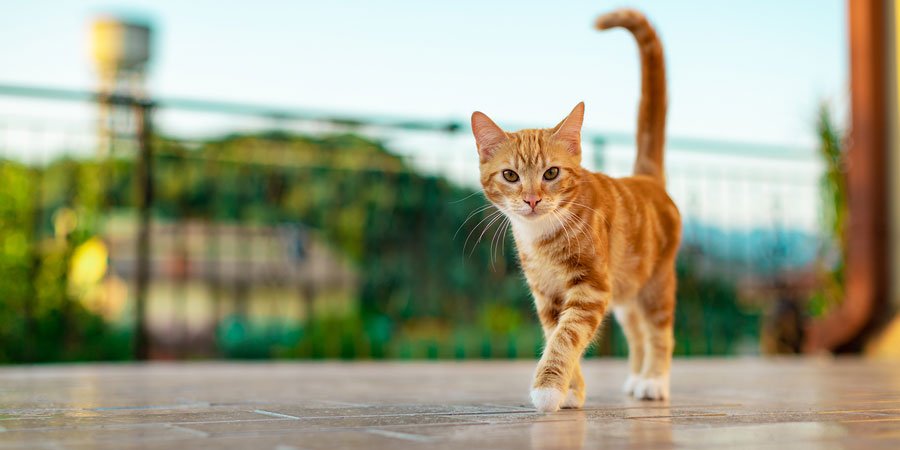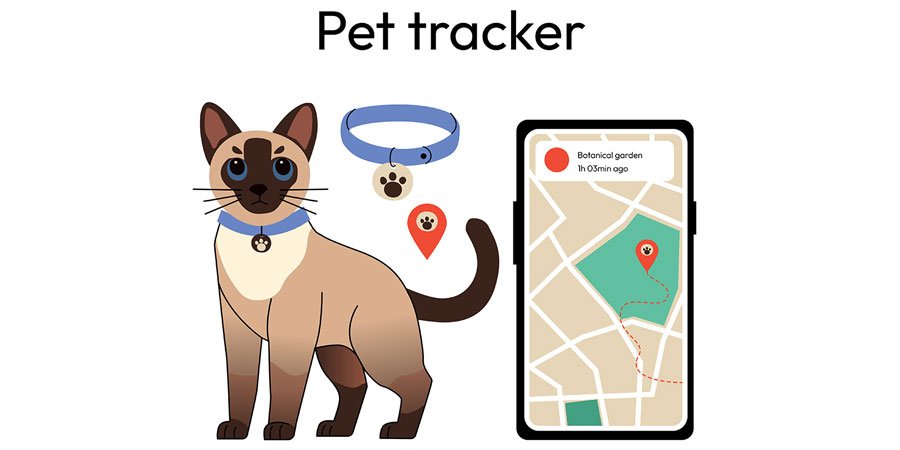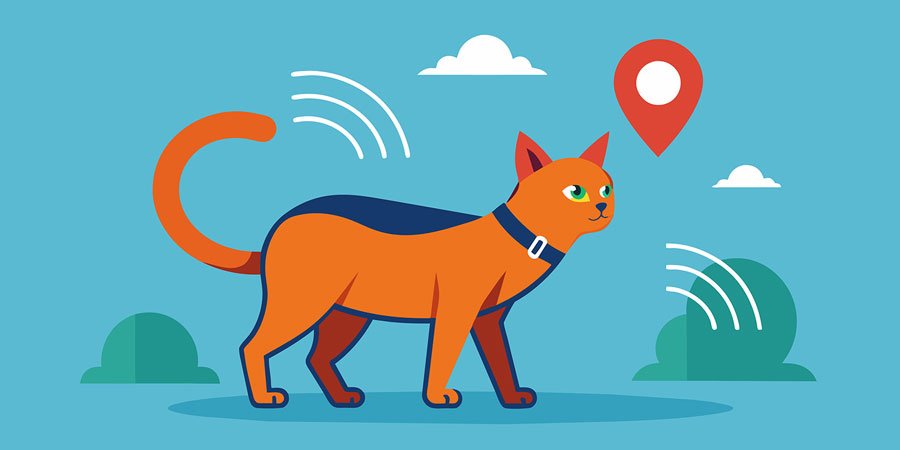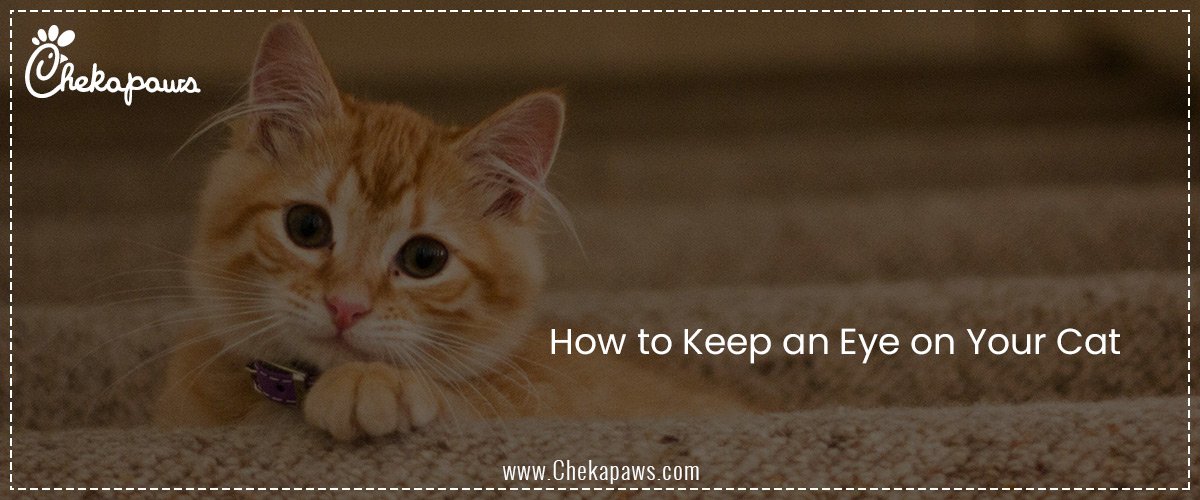As a pet parent, I am aware of cats’ natural curiosity. Even the most well-cared-for indoor cat may yearn to slip outside the front door to pursue insects, shadows, or just plain curiosity. In contrast, outdoor cats may disappear for hours or even days before reappearing with a smug expression and possibly a present you would prefer not to accept.
This can be a source of anxiety for devoted pet owners. It’s enough to keep you up at night to think of your feline friend being lost, hurt, or stuck somewhere. Fortunately, it’s now simpler than ever to monitor your cat’s whereabouts without limiting their mobility thanks to smart pet care techniques and current technology.
The greatest cat tracking gadgets, the reasons behind cats’ wandering, tracking developments, and creative, doable ways to keep your cat safe indoors or out are all covered in this extensive guide.
Table of Contents
Why Cats Wander: Understanding Feline Behaviour

Before learning how to track your cat, it’s essential that you understand the reasons behind their potential for wandering. The environment and evolution have shaped each cat’s instincts.
The Call of the Wild
The wild ancestry of domesticated cats is still present. By their very nature, cats hunt alone. They track their surroundings, investigate territories, and pursue prey. The range of an outdoor cat might range from a few homes to many kilometers.
Curiosity and Territory
Cats have a strong sense of curiosity but are also territorial. To gain authority, they explore nearby regions and use smell glands to designate borders. They may be prompted to look deeper by changes like construction, other cats, or new neighbors.
Mating and Social Behaviour
Cats who are not neutered are much more likely to roam. While female cats in heat may move in pursuit of a mate, male cats may travel great distances to find females. This instinct-driven wandering is greatly reduced by spaying or neutering.
Adventure and Hunting
The excitement of the chase is enjoyed even by well-fed cats. Insects, rodents, and birds arouse their predatory instincts. Cats also explore for pure fun—they can’t resist trying out new smells, textures, and sights.
Stress or Displacement
Cats may stray because they are scared or confused. A flight response could be triggered by a loud noise, a new pet, or a stressful situation at home, which would cause them to go for comfort elsewhere.
These topics may also interest you:
- Helping Your Cat Adjust to a New Home or Space
- How to Manage Pet Anxiety from Fireworks
- How to Tell if Your Cat is in Pain
The Risks of Letting Cats Roam Unsupervised

Despite their resourcefulness, cats pose significant risks while exploring the outdoors.
Traffic Accidents
One of the main causes of cats fatalities is cars. Particularly at night, cats frequently dart across highways in an unexpected way.
Predators and Fights
Dangers can come from uncontrolled dogs, cats, snakes, and even raptors. Territorial conflicts frequently lead to wounds, infections, or infections.
Disease Exposure
Cats who live outdoors are more susceptible to parasites, ticks, FIV, and FeLV. They may also return home with infections.
Theft and Loss
Sometimes, cats with especially pleasant personalities or pedigrees are taken. Others might just stray too far to find their way back, get trapped in garages, or become lost.
Poisoning and Environmental Hazards
Hidden dangers include deadly plants, pesticides, and antifreeze. Wandering outside exposes one to more harmful elements.
Impact on Local Wildlife
Because they are excellent hunters, cats that wander freely can have a big ecological influence on populations of birds and small mammals. This problem is lessened by tracking and controlled visits.
These topics may also interest you:
- 7 Reasons Why Your Cat Is Not Eating
- Fun things to do with your pet
- The history of cats and humans living together
Why Cat Tracking Is Essential

Tracking your cat is important for your safety, well-being, and peace of mind, not simply for your own curiosity.
- Cats that are injured or lost can be found easily.
- To make sure they’re healthy, you can keep an eye on their activity habits.
- Knowing their preferred hiding places or routes will aid you in the event that they disappear.
- By striking a balance between freedom and safety, you may enjoy outdoor time worry-free.
- Technology, training, and behavioural knowledge are all used in modern cat tracking. Let’s examine the resources that enable this.
These topics may also interest you:
- 5 Tips for Training a Stubborn Pet
- Tips for keeping your pet groomed
- Top Tips for Keeping Your Cat Hydrated
Types of Cat Trackers

The functionality, cost, and technology of cat tracking systems varies. The main types are as follows
Trackers with GPS
These track your cat’s whereabouts in real time using satellites. They’re perfect for cats who live outside. Few products are:
Advantages
- Tracking in real time with smartphone apps
- Geofencing notifications and location history
- Operates over extended distances
Disadvantages
- Charge is necessary (battery life 1–7 days)
- Cellular service is required.
- A little bit heavier for tiny kittens
- Ideal For: Large cats, adventurous cats, and outdoor cats
Bluetooth Trackers
For the purpose of pinging location data, Bluetooth gadgets such as Apple AirTag and Tile rely on nearby devices. Few products are:
Advantages
- Lightweight and reasonably priced
- Excellent for cats that live indoors
- No subscription is required.
Disadvantages
- Limited range (less than 100 meters)
- Tracking is limited outside unless in busy areas.
Radio Frequency (RF) Trackers
RF trackers pick up signals from a tag on your cat’s collar using a portable receiver. Few products are:
Advantages
- Operates without cellular service or the internet.
- Extended battery life
- Perfect for rural regions
Disadvantages
- Range is restricted to a few hundred meters.
- No app tracking or real-time map
- Ideal For: Tech-free zones or rural places
Identification of Microchips
Microchips are crucial for identification in the event that your cat is lost, even though they are not a tracking device. To get in touch with you, a shelter or veterinarian can scan the chip.
Advantages
- Long-term identification
- No upkeep
- A must for every cat
Disadvantages
Not a tracker, it only functions when the cat is located.
These topics may also interest you:
- Essential Vaccinations for Cats
- Our Favorite Pet Toothbrushing Products
- 7 Best Pet Insurance Plans And Veterinary Care Options Available
The Best Cat Tracking Devices in 2025
Let’s explore some of the best cat monitoring gadgets on the market right now, as determined by evaluations and expert opinions.
Tractive GPS Cat Tracker
- Range: Unbounded (GPS + cellular)
- Features include an activity monitor, virtual barriers, and real-time tracking.
- Battery life: two to seven days
- Advantages: Waterproof, compact, and precise
- Drawbacks: Needs a subscription
Explore Whistle GO
- Range: cellular + GPS
- Features include activity, health, and real-time tracking information.
- Battery life: 20 days
- Advantages: Great health insights
- Cons: A little big for tiny cats
TabCat RF Tracker
- Range: 122 meters or more
- Features: Cat location directional handset
- Advantages: No membership required, accurate for local searches
- Cons: No mapping of GPS
Apple AirTag
- Range: network tracking and Bluetooth
- Advantages: inexpensive, lightweight, and simple to set up
- Cons: Limited coverage in rural areas; not pet-friendly
- Protective pet collar holders are the ideal companion.
The Jiobit Smart Tag
- Range: Wi-Fi, GPS, and cellular
- Advantages: Minimal, safe clip, real-time updates
- Cons: Requires subscription
These topics may also interest you:
- Interesting Pets That Came Into People’s Lives Unexpectedly
- Tips On Making Pet Costumes Or DIY Pet Fashion Projects
- Why Cats Purr: A Comprehensive Guide
How to Choose the Right Tracker for Your Cat
Your cat’s personality, size, and way of life will all impact which tracker is ideal for them.
Cats in Indoor Environments
- The finest trackers are RF or Bluetooth.
- Pay attention to safety and lightweight devices.
- Try to monitor movement in your yard or house.
Cats in the Outdoors
- For real-time updates, opt for GPS-based trackers.
- Seek designs that are shock-resistant and watertight.
- Make sure the battery lasts for a few days at the very least.
Cats That Take Chances
- The best options are hybrid trackers (like Tractive) or smart collars.
- To create safe areas, use virtual fences.
Senior Cats
Early finding of behavioural changes can be facilitated by smart collars that track health variables or by lightweight GPS trackers.
Households with Several Cats
- Multiple trackers are supported by certain apps.
- Select gadgets with profiles that can be changed.
These topics may also interest you:
- Pet products you can’t live without
- Cat Food Allergies & Adverse Food Reactions
- The Healing Power of Cats
How to Use a Cat Tracker Effectively
Start slowly
Consider allowing your cat to become used to wearing a collar or harness. Introduce the tracker gradually.
Regularly Check the Battery
Dead trackers nullify the purpose, so recharge or replace batteries frequently.
Examine the Range
Before putting your trust in the system, familiarize yourself with the coverage and signal strength.
Create Virtual Boundaries
You can set up geofences with a lot of GPS trackers. If your cat exits a specified safe area, you’ll receive an alert.
Connect Training and Tracking
Combine tracking and recall training with positive reinforcement to teach your cat to come home when called.
Secure Information
Secure your data and app. Location tracking should be restricted to trusted users only.
These topics may also interest you:
- DIY Cat Wall Shelves Ideas Customize Your Cat’s Vertical Playground
- Pet Shopping Guides You Should Read Before Making A Purchase
- 5 Products That Keep Your Pet’s Mind Busy While You’re at Work
Indoor Tracking Ideas (For Homebody Cats)
Tracking isn’t limited to those who enjoy the outdoors. Even indoor cats have the ability to disappear into attics or behind furniture. Here are some smart suggestions
- When they’re hiding, use Bluetooth tags to find them.
- Put cameras in places where kids play.
- For older cats, think about using motion sensors to track movement.
- Use smart monitors to keep tabs on rest, eating, and litter box trips.
These topics may also interest you:
- What You Need to Know About Pet First Aid
- How to Deal with a Jealous Pet
- 5 Common Signs of Stress in Dogs and Cats
Safety Tips for Outdoor Cats
- Make sure your time outside is as safe as possible, even if you have a tracker.
- Each cat has an ID tag and a microchip.
- Update your flea/tick prevention and vaccines.
- Teach your feline to respond to calls.
- Put on breakaway or fluorescent collars.
- Don’t leave them out at night.
- Provide secure outdoor areas such as cat catios, which are enclosed patios.
These topics may also interest you:
- 10 Silly Things Our Pets Do That Are Adorable
- 5 Tips on Drama Free Cat Baths
- How To Keep Your Longhaired Cat’s Fur from Matting
Alternatives to Free Roaming
If you want your cat to enjoy the outdoors but feel uncomfortable letting them roam
Training with a cat harness – Teach your cat to use a leash safely. It can be rewarding, but it requires patience.
Outdoor Enclosures and Catios – Cats may safely enjoy nature, sunlight, and fresh air thanks to enclosed outdoor buildings.
Playtime Under Supervision – Keep your cat visible when you play with them outside. Bring interactive wands, toys, or goodies.
These topics may also interest you:
- How to Introduce Your Pets to a New Baby
- How to Clip Your Pet’s Nails Without the Drama
- Common Behavioral Problems in Cats and How to Fix Them
Behavioural Insights from Tracking Data
These days, trackers can tell you your cat’s habits as well as to its location.
- Sleep habits: Do they take more naps than normal?
- Activity levels: A sharp decline may be a sign of disease.
- Favorite locations: Assists in locating possible dangers or stressful situations.
- Certain smart collars can even notify you of unusual activity, which could be an early warning sign of health issues.
These topics may also interest you:
- How to Help Your Pet Get Over Their Car Anxiety
- 10 DIY Cat Toys
- 5 Challenges That Made Me a Better Pet Parent
When Your Cat Goes Missing
Cats can occasionally escape, even with safety measures in place. Here’s how to move quickly
- Check your tracking app right away.
- Look around—cats tend to hide nearby.
- Use familiar sounds (toys, goodie bag) and make a quiet call.
- Request that neighbors inspect porches, sheds, and garages.
- Post on the internet (local shelters, pet groups).
- Notify animal control and veterinarians.
- Don’t give up, many cats come back after a few days or even weeks.
- If your feline wears a tracker, you can utilize its location history to determine potential hiding places.
These topics may also interest you:
- What to Look for When Adopting a New Cat
- Why Cats Make Amazing Companions
- How to Create a Pet-Friendly Home Without Compromising Style
The Future of Cat Tracking
Cat trackers of the future are developing quickly. Expect
- Solar-charged gadgets that are lighter and smaller.
- Insights on behavior and health driven by AI.
- Integration of smart homes, including synchronization with pet feeders or doors.
- Collars with biometric sensors that measure temperature, tension, and heart rate.
- We will soon be able to keep an almost flawless eye on the safety and well-being of our cats.
These topics may also interest you:
- How to Socialize Your Pet: Tips for Puppies, Kittens & Rescues
- The Rise of Pet Tech: How Smart Devices Are Changing Pet Care
- Senior Pet Care Tips. How to Keep Your Aging Pet Comfortable?
Tracking Beyond Technology: The Human Touch
While technology can be helpful, it’s also important to understand your cat’s behavior and instincts. Keep an eye on their habits, preferred sleeping locations, and signs of happiness or tension.
Spending time together fosters trust. Cats who have faith in their owners are less likely to go far and are more likely to come back when called.
Every day, make time to play, groom, and converse. It gets easier to predict and control their movements the closer you are to them.
These topics may also interest you:
- Indoor vs. Outdoor Cats Pros and Cons
- 10 Ways to Get Involved with Pet Owners in Your City
- Types Of Pet Allergies and How to Treat Them
Conclusion
Despite their need for freedom, cats depend on us for protection. That gap is filled by tracking technology, which gives you peace of mind while letting your cat roam.
Protecting your cat while honoring their nature is the same objective whether you go with a GPS tracker, Bluetooth tag, or catio system.
You can achieve the ideal balance between freedom and protection and guarantee your cherished cat has a long, exciting, and safe life by being aware of feline behaviour, selecting the appropriate equipment, and using it sensibly.
These topics may also interest you:
- How to Introduce a New Cat to Your Home
- How to protect pet dogs, cats and strays from heat wave
- Common health problems in cats and how to prevent them
- 10 Surprising benefits of having a cat in your life
- How to Introduce Your Cat to Other Pets
- Surprising flea facts for dogs and cats
- Why Adopting a Shelter Pet Can Change Your Life (and Theirs Too)
- Purrfect Companions: Exploring the Diversity of Pet Cats
- From Treats to Threats: The Complete Guide to Pet Food Safety
- How Can You Reduce Your Cat’s Body Heat?







